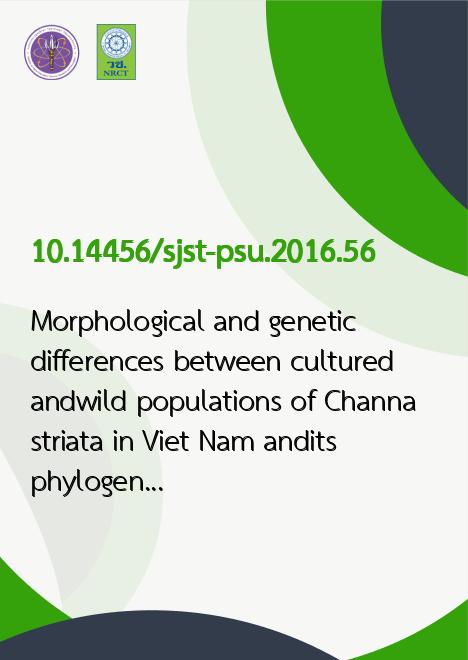
|
Morphological and genetic differences between cultured andwild populations of Channa striata in Viet Nam andits phylogenetic relationship with other Channa species |
|---|---|
| รหัสดีโอไอ | |
| Creator | 1. Ngoc-Tran Thi Nguyen 2. Thuy-Yen Duong |
| Title | Morphological and genetic differences between cultured andwild populations of Channa striata in Viet Nam andits phylogenetic relationship with other Channa species |
| Publisher | Research and Development Office, Prince of Songkla University |
| Publication Year | 2559 |
| Journal Title | Songklanakarin Journal of Science and Technology (SJST) |
| Journal Vol. | 38 |
| Journal No. | 4 |
| Page no. | 427-434 |
| Keyword | Channidae,species classification,DNA barcoding,phylogeny,morphology |
| ISSN | 0125-3395 |
| Abstract | The Channa genus includes important species for aquaculture and interesting targets for phylogenetic studies. In theMekong Delta, Viet Nam, four species of this genus (Channa striata, C. micropeltes, C. lucius, and C. gachua) are naturallydistributed and other phenotypes that look like C. striata have been observed in aquaculture conditions. The taxonomicstatus of newly-observed phenotypes including "triangle-head" snakehead (THS) and square-head snakehead (SHS) is stillcontroversial. This study compared morphological characteristics and Cytochrome C oxidase subunit I (COI) sequences ofdifferent C. striata-like phenotypes and investigated the phylogenetic relationship of Channa species based on COI. Morphologicalresults show that THS, SHS, and wild C. striata have similar ranges for meristic traits but differ in morphometric ratios,especially the shape of their head and length of their gut. Kimura-2P genetic distances among three phenotypes (0.0017-0.0062) are equivalent to those of C. striata samples from Mainland Southeast Asian countries. The results indicate that THSand SHS belong to C. striata, and this species exhibits within-species diversity in both morphology and COI sequences.The phylogenetic analysis indicates that C. striata individuals form a monophyletic group and are genetically distinct fromother Channa species in the Vietnamese Mekong Delta. Congeneric distances of four species range from 0.1836 to 0.2436,indicating high divergence among Channa species. |
